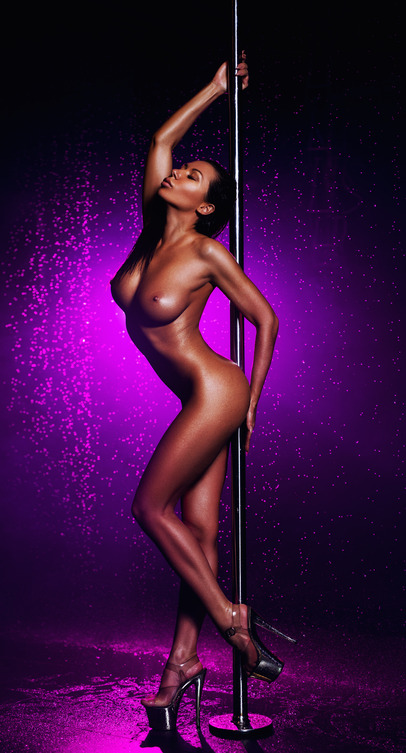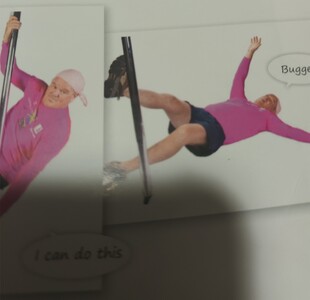
It all goes back to Mugwump—a curiously named strip joint in Oregon, USA—where the beautiful Belle Jangles performed the first pole dance in 1968. From there, pole dancing became a thang. According to Vocabulary.com, “mugwump” is a Native American word meaning "war leader." Later, in the U.S., it evolved into political slang for a Republican fence-sitter—someone who can't quite commit to either side (or pole, as it were).
The Charlotte Post suggests the history of pole dancing stretches even further back, tracing its roots to the circus era. During the early 1900s economic downturn, traveling shows would use “Hoochie Coochie” dancers performing on wooden tent poles to draw in crowds and extra income. Some scholars even point to ye olde English Maypole dances as a possible precursor—though those ladies kept their voluminous clothes on, bless them.
Wherever it began, pole dancing first found solid footing (or heels) in strip clubs across the U.S., then Australia. But the art form has long outgrown its hootchie-coochie origins. These days, it's a respected fitness pursuit and an internationally recognized sport, with championships and choreographed routines that demand serious strength, flexibility, and athleticism—primarily performed by women.
There's also a theory that pole dancing may have been influenced by Mallakhamb, a traditional Indian practice combining wrestling, yoga-like poses, and strength training—all performed on a vertical pole or rope. According to AI Meta (and yes, sometimes she gets it right), Mallakhamb developed in Maharashtra, India, and was traditionally used to train male wrestlers. Men practiced on poles, while women typically used ropes—so maybe there’s a crossover history here, albeit with very different vibes.

Now, I must admit—without the help of AI—that your humble correspondent once nearly claimed the title of Mr. Perth Pole Dancing back in the day. I say "nearly" because, during a particularly ambitious gold-medal routine, I slipped on a sweaty pole while attempting the now-banned 68½ pole move. The resulting photo of me sprawled beneath the pole (shorts askew, dignity somewhere in the rafters) has since become known in niche circles as the money shot.
But enough about me.
Because pole dancing was born and bred in strip joints—especially in the U.S.—it naturally became a tool in the kits of dancers and sex workers alike. And let’s be honest: a fit, nearly nude woman in sky-high heels spinning upside down on a pole with legs akimbo is likely to stir something in most men.
Still, Ms. Google (via Meta AI) tells us:
“While pole dancing has roots in the sex industry, it is not inherently sexual or exploitative. Many people engage in pole dancing for fitness, artistic expression, and personal empowerment, without any connection to the sex industry.”
And while I respect that view, I’ll admit this: every pole dancer I’ve ever admired has been inherently sexy. Maybe it’s the heels. Maybe it’s the gravity-defying athleticism. Maybe it’s the near-total lack of clothing. Who can say?
Here in Perth, strip clubs are becoming a relic. Without the hootchie, there’s nowhere left to house the coochie—or her pole.
Perhaps the conclusion to the question raised is best said by Gloriousport.com as follows;
Pole as it's practiced in studios is definitely influenced and pioneered by strippers, not mallakhamb. You are literally doing tricks invented by strippers, and if you wear heels, you are wearing shoes strippers wear for work. You cannot distance pole dance from sex work- pole dance comes from sex work. (19 Mar 2024.)
Author: Magnum
(Almost Mr Perth Pole Dancing Champ)
For: Langtrees.com
TalkinSex Forum | Perth Escorts | Sydney Escorts | Melbourne Escorts | Brisbane Escorts | Darwin Escorts | Adelaide Escorts | Hobart Escorts | New Zealand Escorts

“That story about the 68½ pole move had me laughing! ? Loved how you mixed humour with real facts. Pole dancing is definitely sexy, but also super athletic. Great read.”

“The connection between Pole Dancing and Prostitution is primarily historical and contextual, not inherent. I enjoy debates and i found this quite engaging. Well written. ”

““Great read! It’s good to see the difference between pole dancing as a prostitution and the wrong ideas people have about it. Thanks for helping to clear things up.””

“Another great read Magnum In my dreams I am a great pole dancer :-)”

“A good pole dancer is superbly fit. Pole dancing is to the body what super foods are to diets - an allrounder. Pole dancing requires strength, balance, flexibility and coordiantion - in other words a full body work out. Interesting that it originated in India - never really thought about the history of pole dancing. I always thought of it as a modern form of gymnastics. ”

“People often mix Pole Dancing with Prostitution. Or in better words, it seems Pole dancers or Strippers are like Prostitutes. But the statement is not wholly true. There are many pole dancers who act for fitness, artistic expression, and personal empowerment, not for engaging in any sexual intercourse. They even have no connections with the sex industry.”

“Wow, what a great blog!? I feel so proud after reading that Pole dancing originated in India, as all this time I was thinking it could be taken from Spanish dance, as most of the moves I feel are the same. ?it all started 1980s.. that's a long time. ”

“Loved this trip down the pole (history)! The connection between pole dancing and sex work is as real as a pair of 8-inch Pleasers. Sure, pole’s gone mainstream—it's in gyms, competitions, even on reality shows where nobody knows what to do with their hands. But strippers made an artform out of defying gravity while making rent. Respect the roots—and the roots are wearing glitter, lashes, and heels you could fend off a bear with. ;)”

“Pole dancing is a very old art. Pole dancing has evolved into a powerful and popular form of physical activity and self-expression. Pole dancing has its roots in the stripper and sex work culture. It is completely affiliated with the lives and experiences of strippers and sex workers, who were and continue to be key figures in the development of this form of dance.”

“Always was stunned by the exceptional pole dancing performed by the ladies in bars and strip clubs never knew so much before how it all got started and how was it founded. This is the best pole dancing blog I have ever come across, thanks to the blog for being so educative and engaging.”

“That’s so interesting to know that it originated in India. For some reason I thought it possibly may have come from the Burlesque dancers. I love the name for the circus dancers “Hoochie Coochie” How awesome would it have been to see them perform! ”

“Pole dancing began in strip clubs in the U.S. and Australia but has evolved into a respected fitness pursuit and sport. Today, it features championships and routines highlighting strength, flexibility, and athleticism, primarily performed by women. It's inspiring to see how far this art form has come!”

“Yes, pole dancing has historical and cultural connections to prostitution, particularly through its origins in sex work and the stigma surrounding both practices. ”

“If you visit India, you may be familiar with Mallakhamba, an ancient fitness practice performed by both boys and girls. In the Western world, the stereotype surrounding pole dancing is often linked to its origins in strip clubs. While we now understand that dancing is not inherently sexual, many people remain trapped in outdated perceptions. Pole dancing is an excellent form of exercise, and recently, pole yoga has emerged as an additional practice. You don’t need high heels or a sexy outfit to participate; what you truly need is strength and dedication. It’s all about mindset. Some argue that pole dancing should be banned simply because of its origins; by that logic, we should consider banning dancing altogether, or even high heels and the entire female gender. Such thinking is misguided. Today, you can also find men participating in pole fitness classes. If you’re looking for a fresh perspective on this art form, consider visiting India.”